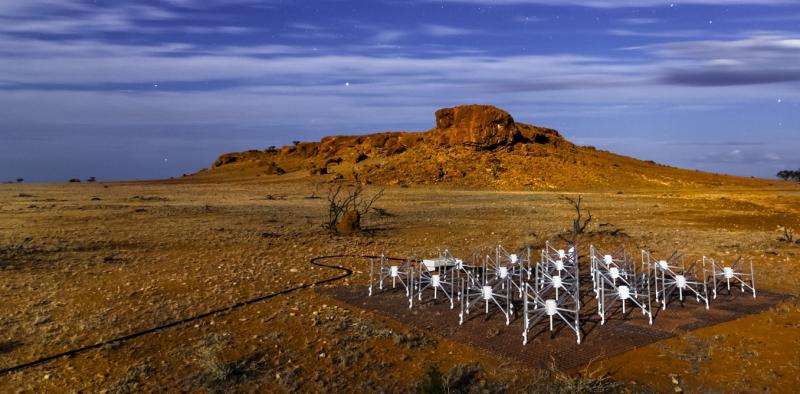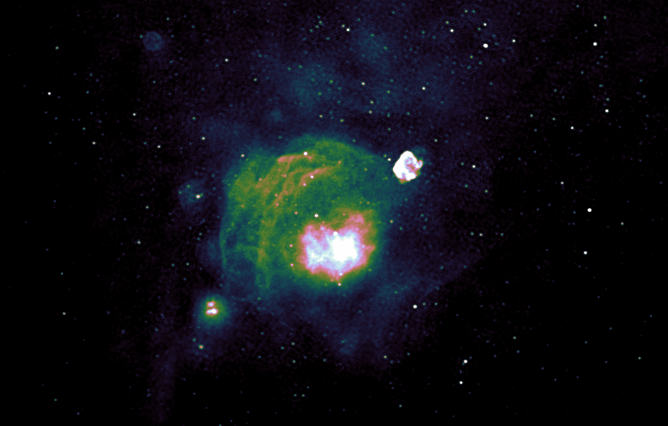Tuning in to cosmic radio from the dawn of time

Many wonders of the universe cannot be seen in visible light. Rather, we need to explore the rest of the electromagnetic spectrum to reveal their splendour.
Some stars and galaxies emit radio waves at frequencies of hundreds of megahertz. A megahertz is one million hertz, which means one million waves pass by per second. This range is the same as many human sources of radio waves, for example our national broadcasater's youth radio station, Triple J, which broadcasts at 105.7MHz in Sydney, and 99.3MHz in Perth.
We also know that hydrogen atoms emit radiation when their configuration changes. The early universe consisted almost entirely of hydrogen atoms, but at some point – probably about 500 million years after the Big Bang – the first stars formed.
Astronomers predict we should be able to see radiation from the early universe at low radio frequencies, so we need to tune to the 80 to 300 megahertz range in order to detect this so-called "Epoch of Reionization".
There are some impressive radio telescopes around the globe, including here in Australia, such as the iconic "Dish" in Parkes. But there's a new kind of low frequency radio telescope, the Murchison Widefield Array (MWA), that is based in some of the most remote regions of the outback.
And thanks to a recent grant from the Federal Government, it's about to quadruple in size.
Massive eyes on the sky
The first thing most people notice about the MWA is that it doesn't look like a traditional dish telescope such as the one at Parkes. It looks more like an army of robot spiders (see the drone video below).
The MWA consists of 2,048 antennas (the robot spiders), each of which can see almost the whole visible sky simultaneously. This is hundreds of time greater than a traditional radio telescope.
These eyes allow us to watch the sky constantly, monitoring it for changes. The more of the sky we can see, the more likely we are to capture rare events. For example, when the solar wind interacts with Jupiter's magnetic field, it causes massive flares.
When this happens, Jupiter is temporarily as bright as the sun at radio frequencies. We are using the MWA to search for similar flares coming from planets in other solar systems, as well as catching a whole range of other transient events in action.
Connecting the spiders together
The MWA antennas are arranged in 128 groups (or tiles) spread over nine square kilometres in the Western Australian outback. This type of telescope is called an interferometer: the information from all of the tiles is combined together using computers, letting us create a unique picture of the sky.

The video below shows how the MWA interferometer is equivalent to a large single dish, but one kilometres in diameter. If you want to get a feel for its size, you can take a Google Streetview tour of the MWA.
The tiles that are close together let us see large-scale structures on the sky, such as the shells left behind when nearby stars explode as supernova at the end of their lives, as shown in the image below.
The tiles that are farthest apart give us high resolution, letting us detect small-scale objects such as pulsars. The extended MWA, spreading over roughly 20 square kilometres, will improve these capabilities, giving us an incredible picture of both our own Milky Way galaxy and the distant universe.
A radio quiet home
Modern society is full of radio-emitting devices: mobile phones; microwaves; and even Fitbits. To detect weak signals from space the MWA has to be extremely sensitive. But this means it can also pick up the radio emission from all our devices.
To overcome this problem the MWA was built in a Radio Quiet Zone, which means that no radio-emitting devices are allowed. Computers and other essential engineering tools are shielded in a specially designed building.
The Western Australia outback is one of the best places in the world you could build the MWA, and in the future this site will become the home of the low frequency Square Kilometre Array.
An incredible telescope
The upgraded MWA has an ambitious science program, but perhaps more exciting is the prospect of discovering something unexpected. We saw the first example of this last year, when undergraduate student Cleo Loi used the telescope to image "waves in the sky": incredible plasma structures in the Earth's ionosphere, as shown in the video below.
The challenges of building facilities on the edge of technology and innovation, like the MWA, in an environment like the Murchison region, are extreme, but worth it.
Uncovering a deeper truth about the universe is what drives science and scientists. This, in turn, helps drive the technology development that is critical for an economy based on innovation. This is where Australia needs to be in decades to come and challenging, fundamental projects like the MWA will help us get there.
Source: The Conversation
This article was originally published on The Conversation. Read the original article.
![]()




















